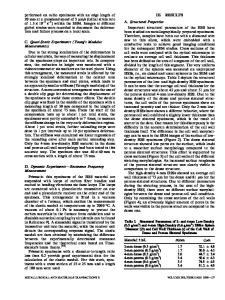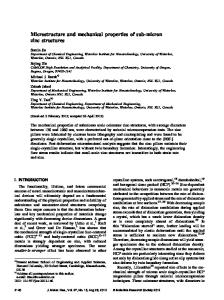Mechanical Properties of Micromachined Structures
To be able to accurately design structures and make reliability predictions, in any field it is necessary first to know the mechanical properties mechanical properties of the materials that make up the structural components. In the fields of microelectrom
- PDF / 3,003,914 Bytes
- 16 Pages / 547.146 x 686 pts Page_size
- 73 Downloads / 381 Views
Mechanical Pr 34.1 Measuring Mechanical Properties of Films on Substrates........................... 1023 34.1.1 Residual Stress Measurements ...... 1023 34.1.2 Mechanical Measurements Using Nanoindentation ................ 1024 34.2 Micromachined Structures for Measuring Mechanical Properties ...... 1024 34.2.1 Passive Structures........................ 1025 34.2.2 Active Structures ......................... 1028 34.3 Measurements of Mechanical Properties . 1034 34.3.1 Mechanical Properties of Polysilicon .............................. 1034 34.3.2 Mechanical Properties of Other Materials ....................... 1036 References .................................................. 1037
performed will then be summarized, in particular the values obtained for polycrystalline silicon (polysilicon).
34.1 Measuring Mechanical Properties of Films on Substrates In order to determine accurately the mechanical properties of very small structures, it is necessary to test specimens made from the same materials, processed in the same way, and of the same approximate size. Not surprisingly it is often difficult to handle specimens this small. One solution is to test the properties of films remaining on substrates. Micro- and nanomachined structures are typically fabricated from films that are initially deposited onto a substrate, are subsequently patterned and etched into the appropriate shapes, and then finally released from the substrate. If the testing is performed on the continuous film, before patterning and release, the substrate can be used as an effective “handle” for the specimen (in this case, the film). Of course since the films are adhered to the substrate, the types of tests possible are severely limited.
34.1.1 Residual Stress Measurements One common measurement easily performed on films attached to substrates is residual film stress. The curvature of the substrate is measured before and after film deposition. Curvature can be measured in a number of ways. The most common technique is to scan a laser across the surface (or scan the substrate beneath the laser) and detect the angle of the reflected signal. Alternatively, profilometry, optical interferometry, or even atomic force microscopy can be used. As expected, tools that map a surface or perform multiple linear scans can give more accurate readings than tools that measure only a single scan. Assuming that the film is thin compared to the substrate, the average residual stress in the film, σf , is given
Part E 34
To be able to accurately design structures and make reliability predictions, in any field it is necessary first to know the mechanical properties of the materials that make up the structural components. In the fields of microelectromechanical systems (MEMS) and nanoelectromechanical systems (NEMS), the devices are necessarily very small. The processing techniques and microstructures of the materials in these devices may differ significantly from bulk structures. Also, the surface-area-to-volume ratio in these structures is much higher than in bulk sa
Data Loading...










